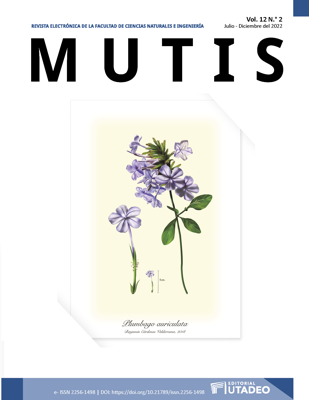
Esta obra está bajo una licencia internacional Creative Commons Atribución-NoComercial-CompartirIgual 4.0.
Esta obra está bajo una licencia internacional Creative Commons Atribución-NoComercial-CompartirIgual 4.0.
Resumen
Colombia ocupa el puesto 89 de 124 países que concentran la mayor cantidad de plagas, y los fitopatógenos fúngicos, por las condiciones climáticas que caracteriza la zona geográfica, son uno de los mayores problemas para los cultivos de hortalizas. El control biológico es una alternativa sustentable y prometedora al uso exclusivo de agroquímicos. En diversos estudios se ha observado que la bacteria Pseudomonas tiene un gran potencial biocontrolador para hongos fitopatógenos como Fusarium spp., Sclerotinia sclerotiorum, Rhizoctonia spp., entre otros, que causan pérdidas en la producción de hortalizas. Existen más de cien especies de Pseudomonas reportadas, de las cuales varias cepas han mostrado resultados prometedores. Materiales y métodos: en esta esta revisión sistemática se emplearon los lineamientos del sitio web Systematic Reviews and Meta-Analyses y se realizaron búsquedas en bases de datos y en páginas web de instituciones como Agrosavia, Agronet, el Instituto Colombiano Agropecuario (ica), e Instituto de Hidrología, Meteorología y Estudios Ambientales (ideam). Resultados: se obtuvo un total de 97 artículos publicados entre 1980 y 2021. Posterior a la aplicación de los criterios de inclusión y exclusión, se eliminaron 43 publicaciones, por lo que, en total, 54 publicaciones se incluyeron. Discusión: diversas cepas de Pseudomonas evidencian un potencial biocontrolador favorable que permite adoptar y desarrollar técnicas innovadoras para introducirse en el manejo de fitopatógenos. Sus propiedades, además de contrarrestar la enfermedad, favorecen el crecimiento y la productividad de las plantas. Varios estudios comprueban los mecanismos que expresan las Pseudomonas y el rol prometedor de la genómica en su potenciación. Conclusiones: el género Pseudomonas ha resultado ser efectivo como biocontrolador de fitopatógenos en cultivos de hortalizas, cuyos tratamientos con esta bacteria pueden llegar a reducir el uso de agroquímicos. Sin embargo, es necesario implementar nuevas estrategias e incentivar la investigación en este campo.
Citas
Aguado-Santacruz, G., A., Moreno-Gómez, B., Jiménez-Francisco, B., García-Moya, E. y Preciado-Ortiz, R., E. (2012). Impacto de los sideróforos microbianos y fitosidéforos en la asimilación de hierro por las plantas: una síntesis. Revista fitotecnia mexicana, 35(1), 9-21. https://doi.org/10.35196/rfm.2012.1.9
Álvarez, J., Santoyo, G. y Rocha, M. (2020). Pseudomonas fluorescens: Mecanismos y aplicaciones en la agricultura sustentable. Revista Latinoamericana De Recursos Naturales, 16(1), 1-10. https://doi.org/10.33154/rlrn.2020.01.01
Anand, T., Chandrasekaran, A., Kuttalam, S., Senthilraja, G., & Samiyappan, R. (2010). Integrated control of fruit rot and powdery mildew of chilli using the biocontrol agent Pseudomonas fluorescens and a chemical fungicide. Biological Control, 52(1), 1-7. https://doi.org/10.1016/j.biocontrol.2009.09.010
Anderson, A., & Kim, Y. (2018). Biopesticides produced by plant-probiotic Pseudomonas chlororaphis isolates. Crop Protection, 105, 62-69. https://doi.org/10.1016/j.cropro.2017.11.009
Arya, N., Rana, A., Rajwar, A., Sahgal, M. & Sharma, A. (2018). Biocontrol Efficacy of Siderophore Producing Indigenous Pseudomonas Strains Against Fusarium Wilt in Tomato. National Academy Science Letters, 41(3), 133-136. https://doi.org/10.1007/s40009-018-0630-5
Bauer, J., Hauck, N., Christof, L., Mehnaz, S., Gust, B. & Gross, H. (2016). The Systematic Investigation of the Quorum Sensing System of the Biocontrol Strain Pseudomonas chlororaphis subsp. aurantiaca PB-St2 UnveilsaurI to Be a Biosynthetic Origin for 3-Oxo-Homoserine Lactones. PLOS ONE, 11(11). https://doi.org/10.1371/journal.pone.0167002
Berry, C., Fernando, W., Loewen, P. & de Kievit, T. (2010). Lipopeptides are essential for Pseudomonas sp. DF41 biocontrol of Sclerotinia sclerotiorum. Biological Control, 55(3), 211-218. https://doi.org/10.1016/j.biocontrol.2010.09.011
Bolwerk, A. et al. (2003). Interactions in the tomato rhizosphere of two Pseudomonas biocontrol strains with the phytopathogenic fungus fusarium oxysporum f. sp. radicis-lycopersici: MPMI. Molecular Plant-Microbe Interactions, 16(11), 983-993. https://doi.org/10.1094/MPMI.2003.16.11.983
Chaudhari B.L., Patil S.N., Paradeshi J.S., Chaudhari M.A. & Chaudhari C.S. (2017) Premier Biocontrol Traits of Pseudomonads: Siderophores, Phenazines or What Else? Microorganisms for Sustainability. https://doi.org/10.1007/978-981-10-6241-4_18
Chlebek, D., Pinski, A., Żur, J., Michalska, J. & Hupert-Kocurek, K. (2020). Genome Mining and Evaluation of the Biocontrol Potential of Pseudomonas fluorescens BRZ63, a New Endophyte of Oilseed Rape (Brassica napus L.) against Fungal Pathogens. International Journal Of Molecular Sciences, 21(22), 8740. https://doi.org/10.3390/ijms21228740
Correa É. (Mar.25,2020). La hora de las hortalizas. Agronegocios. https://cutt.ly/lAqMrr9
Cucu, M., Gilardi, G., Pugliese, M., Matić, S., Gisi, U., Gullino, M. & Garibaldi, A. (2018). Influence of different biological control agents and compost on total and nitrification-driven microbial communities at rhizosphere and soil level in a lettuce -Fusarium oxysporumf. sp. lactucaepathosystem. Journal of Applied Microbiology, 126(3), 905-918. https://doi.org/10.1111/jam.14153
Dave, K., Gothalwal, R., Singh, M. & Joshi, N. (2020). Facets of rhizospheric microflora in biocontrol of phytopathogen Macrophomina phaseolina in oil crop soybean. Archives Of Microbiology, 203(2), 405-412. https://doi.org/10.1007/s00203-020-02046-z
Delany, I., Walsh, U., Ross, I., Fenton, A., Corkery, D. & O'Gara, F. (2001). Enhancing the biocontrol efficacy of Pseudomonas fluorescens F113 by altering the regulation and production of 2,4-diacetylphloroglucinol. Plant And Soil, 232(1/2), 195-205. https://doi.org/10.1007/978-94-010-0566-1_19
Domenech, J., Reddy, M., Kloepper, J., Ramos, B. & Gutierrez-Mañero, J. (2006). Combined Application of the Biological Product LS213 with Bacillus, Pseudomonas or Chryseobacterium for Growth Promotion and Biological Control of Soil-Borne Diseases in Pepper and Tomato. Biocontrol, 51(2), 245-258. https://doi.org/10.1007/s10526-005-2940-z
Duke, K., Becker, M., Girard, I., Millar, J., Dilantha Fernando, W., Belmonte, M. & de Kievit, T. (2017). The biocontrol agent Pseudomonas chlororaphis PA23 primes Brassica napus defenses through distinct gene networks. BMC Genomics, 18(1). https://doi.org/10.1186/s12864-017-3848-6
Emmanuel, O. & Babalola, O. (2020). Productivity and quality of horticultural crops through co-inoculation of arbuscular mycorrhizal fungi and plant growth promoting bacteria. Microbiological Research, 239, 126569. https://doi.org/10.1016/j.micres.2020.126569
Felipe, V., Bianco, M., Terrestre, M., Mielnichuk, N., Romero, A. y Yaryura, P. (2021). Control biológico de la mancha bacteriana del tomate mediante cepas novedosas de Bacillus y Pseudomonas. Revista europea de patología vegetal, 160(4), 935-948. https://doi.org/10.1016/j.cropro.2006.04.007
Fernando, W., Nakkeeran, S., Zhang, Y. & Savchuk, S. (2007). Biological control of Sclerotinia sclerotiorum (Lib.) de Bary by Pseudomonas and Bacillus species on canola petals. Crop Protection, 26(2), 100-107.
Fina, B., Lombarte, M. y Rigalli, A. (2013). Investigación de un fenómeno natural: ¿estudios in vivo, in vitro o in sillico?
Fuchs, J. (2000). The laboratory medium used to grow biocontrol Pseudomonas sp. Pf153 influences its subsequent ability to protect cucumber from black root rot. Soil Biology And Biochemistry, 32(3), 421-424. https://doi.org/10.1016/S0038-0717(99)00169-8
Gao, G., Yin, D., Chen, S., Xia, F., Yang, J., Li, Q. & Wang, W. (2012). Effect of Biocontrol Agent Pseudomonas fluorescens 2P24 on Soil Fungal Community in Cucumber Rhizosphere Using T-RFLP and DGGE. Plos ONE, 7(2), https://doi.org/10.1371/journal.pone.0031806
Großkinsky, D. et al. (2016). Cytokinin production by Pseudomonas fluorescens G20-18 determines biocontrol activity against Pseudomonas syringae in Arabidopsis. Scientific Reports, 6(1). https://doi.org/10.1038/srep23310
Gilardi, G., Pugliese, M., Gullino, M. & Garibaldi, A. (2020). Effect of biocontrol agents and potassium phosphite against Phytophthora crown rot, caused by Phytophthora capsici, on zucchini in a closed soilless system. Scientia Horticulturae, 265, 109207. https://doi.org/10.1016/j.scienta.2020.109207
Hultberg, M., Holmkvist, A. & Alsanius, B. (2011). Strategies for administration of biosurfactant-producing pseudomonads for biocontrol in closed hydroponic systems. Crop Protection, 30(8), 995-999. https://doi.org/10.1016/j.cropro.2011.04.012
Hwangbo, H., Kim, K. & Choi, H. (2016). Effects of biocontrol agents on suppression of damping-off in Cucumis sativus L. caused by Rhizoctonia solani. Horticulture, Environment, And Biotechnology, 57(2), 191-196. https://doi.org/10.1007/s13580-016-0163-0
ICA. (2012). Manejo fitosanitario del cultivo de hortalizas. Ica.gov.co. https://www.ica.gov.co/getattachment/bb883b42-80da-4ae5-851f-4db05edf581b/Manejo-fitosanitario-del-cultivo-de-hortalizas.aspx.
Instituto Nacional de Salud. (2020). Boletín epidemiológico semanal 05 de 2020. Boletín Epidemiológico Semanal, 1-30. https://doi.org/10.33610/23576189.2020.05
Izzeddin, A, N. y Medina, T. L. (2011). Efecto del control biológico por antagonistas sobre fitopatógenos en vegetales de consumo humano. Salus, 15(3), 8-12.
Khalil, S., Ali, T., Skory, C., Slininger, P. & Schisler, D. (2016). Evaluation of economically feasible, natural plant extract-based microbiological media for producing biomass of the dry rot biocontrol strain Pseudomonas fluorescens P22Y05 in liquid culture. World Journal Of Microbiology And Biotechnology, 32(2). https://doi.org/10.1007/s11274-015-1984-1
Kamou, N., Cazorla, F., Kandylas, G. & Lagopodi, A. (2019). Induction of defense-related genes in tomato plants after treatments with the biocontrol agents Pseudomonas chlororaphis ToZa7 and Clonostachys rosea IK726. Archives Of Microbiology, 202(2), 257-267. https://doi.org/10.1007/s00203-019-01739-4
Mercado-Blanco, J. (2014). Pseudomonas Strains that Exert Biocontrol of Plant Pathogens. Pseudomonas, 121-172. https://doi.org/10.1007/978-94-017-9555-5_6
Mishra, S. y Arora, N. (2011). Evaluación de Pseudomonas y Bacillus rizosféricos como herramienta de biocontrol para Xanthomonas campestris pv campestris. Revista mundial de microbiología y biotecnología, 28 (2), 693-702. https://doi.org/10.1007/s11274-011-0865-5
Moruzzi, S., Firrao, G., Polano, C., Borselli, S., Loschi, A., Ermacora, P., Loi, N., y Martini, M. (2017) Caracterización genómica asistida de Pseudomonas sp. cepa Pf4, un potencial agente de control biológico en hidroponía. Ciencia y Tecnología de Biocontrol, 27(8), 969-991. https://doi.org/10.1080/09583157.2017.1368454
Mukerji, K. (2004). Fruit and vegetable diseases. Springer. https://doi.org/10.1007/0-306-48575-3
Naseby, D., Moënne-Loccoz, Y., Powell, J., O'Gara, F. & Lynch, J. (1998). Soil enzyme activities in the rhizosphere of field-grown sugar beet inoculated with the biocontrol agent Pseudomonas fluorescens F113. Biology And Fertility Of Soils, 27(1), 39-43. https://doi.org/10.1007/s003740050397
Negi, Y., Prabha, D., Garg, S. & Kumar, J. (2010). Genetic Diversity Among Cold-Tolerant Fluorescent Pseudomonas Isolates from Indian Himalayas and Their Characterization for Biocontrol and Plant Growth Promoting Activities. Journal Of Plant Growth Regulation, 30(2), 128-143. https://doi.org/10.1007/s00344-010-9175-7
Oliver, C., Hernández, I., Caminal, M., Lara, J. & Fernàndez, C. (2019). Pseudomonas putida strain B2017 produced as technical grade active ingredient controls fungal and bacterial crop diseases. Biocontrol Science And Technology, 29(11), 1053-1068. https://doi.org/10.1080/09583157.2019.1645304
Pal, K., Tilak, K., Saxena, A., Dey, R. & Singh, C. (2000). Antifungal characteristics of a fluorescent Pseudomonas strain involved in the biological control of Rhizoctonia solani. Microbiological Research, 155(3), 233-242. https://doi.org/10.1016/S0944-5013(00)80038-5
Péchy-Tarr, M. et al. (2005). RpoN (σ54) controls production of antifungal compounds and biocontrol activity in Pseudomonas fluorescens CHA0: MPMI. Molecular Plant-Microbe Interactions, 18(3), 260-272. https://doi.org/10.1094/MPMI-18-0260
Pérez Álvarez, S., Coto Arbelo, O., Echemendía Pérez, M. & Ávila Quezada (2015). Pseudomonas fluorescens Migula, ¿control biológico o patógeno? Revista de Protección Vegetal, 30(3), 225-234.
Postma, J. & Nijhuis, E. (2019). Pseudomonas chlororaphis and organic amendments controlling Pythium infection in tomato. European Journal Of Plant Pathology, 154(1), 91-107. https://doi.org/10.1007/s10658-019-01743-w
Rodríguez, M., Torres, M., Blanco, L., Béjar, V., Sampedro, I. & Llamas, I. (2020). Plant growth-promoting activity and quorum quenching-mediated biocontrol of bacterial phytopathogens by Pseudomonas segetis strain P6. Scientific Reports, 10(1). https://doi.org/10.1038/s41598-020-61084-1
Sandani, H., Ranathunge, N., Lakshman, P. & Weerakoon, W. (2019). Biocontrol potential of five Burkholderia and Pseudomonas strains against Colletotrichum truncatuminfecting chilli pepper. Biocontrol Science And Technology, 29(8), 727-745. https://doi.org/10.1080/09583157.2019.1597331
Santoyo G., Valencia-Cantero, E., Orozco-Mosqueda, M., Peña-Cabriales, J. y Farías-Rodríguez, R., (2010). Papel de los sideróforos en la actividad antagónica de Pseudomonas fluorescens ZUM80 hacia hongos. Terra Latinoamericana, 28(1),53-60.
Singh, N. & Siddiqui, Z. (2014). Effects of Bacillus subtilis, Pseudomonas fluorescens and Aspergillus awamori on the wilt-leaf spot disease complex of tomato. Phytoparasitica, 43(1), 61-75. https://doi.org/10.1007/s12600-014-0427-0
Strano, C., Bella, P., Licciardello, G., Caruso, A. & Catara, V. (2017). Role of secondary metabolites in the biocontrol activity of Pseudomonas corrugata and Pseudomonas mediterranea. European Journal Of Plant Pathology, 149(1), 103-115. https://doi.org/10.1007/s10658-017-1169-x
Troxler, J., Svercel, M., Natsch, A., Zala, M., Keel, C., Moënne-Loccoz, Y. & Défago, G. (2012). Persistence of a biocontrol Pseudomonas inoculant as high populations of culturable and non-culturable cells in 200-cm-deep soil profiles. Soil Biology And Biochemistry, 44(1), 122-129. https://doi.org/10.1016/j.soilbio.2011.09.020
Vinchira-Villarraga, D. y Moreno-Sarmiento, N. (2019). Control biológico: Camino a la agricultura moderna. Revista Colombiana De Biotecnología, 21 (1), 2-5. https://doi.org/10.15446/rev.colomb.biote.v21n1.80860
Yanez, M. (2014). Caracterizacion de una cepa de Pseudomonas fluorescens promotora del crecimiento vegetal (tesis doctoral). Area de Biología, Universidad de Chile.
Yin, D., Wang, N., Xia, F., Li, Q. & Wang, W. (2013). Impact of biocontrol agents Pseudomonas fluorescens 2P24 and CPF10 on the bacterial community in the cucumber rhizosphere. European Journal Of Soil Biology, 59, 36-42. https://doi.org/10.1016/j.ejsobi.2013.09.001
Zhou, T., Li, C., Chen, D., Wu, K., Shen, Q. & Shen, B. (2014). phlF− mutant of Pseudomonas fluorescens J2 improved 2,4-DAPG biosynthesis and biocontrol efficacy against tomato bacterial wilt. Biological Control, 78, 1-8. https://doi.org/10.1016/j.biocontrol.2014.07.006
Zohara, F., Akanda, M., Paul, N., Rahman, M. & islam, M. (2016). Inhibitory effects of Pseudomonas spp. on plant pathogen Phytophthora capsici in vitro and in planta. Biocatalysis And Agricultural Biotechnology, 5, 69-77. https://doi.org/10.1016/j.bcab.2015.12.009
Descargas
Datos de publicación
Perfil evaluadores/as N/D
Declaraciones de autoría
- Sociedad académica
- Universidad de Bogotá Jorge Tadeo Lozano
- Editorial
- Universidad de Bogotá Jorge Tadeo Lozano

 PDF
PDF
 FLIP
FLIP













